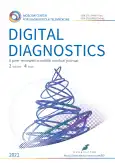Use of magnetic resonance imaging features as radiomic markers in pre-operative evaluation of extra-axial tumor grade
- Authors: Bergen T.A.1, Soynov I.A.1, Pustovetova M.G.1
-
Affiliations:
- E. Meshalkin National Medical Research Center
- Issue: Vol 2, No 4 (2021)
- Pages: 431-440
- Section: Original Study Articles
- URL: https://journals.rcsi.science/DD/article/view/81617
- DOI: https://doi.org/10.17816/DD81617
- ID: 81617
Cite item
Abstract
BACKGROUND: Extra-axial tumors are one of the tumor groups with difficult primary differential diagnostics. Detection and standardization of radiomic markers are one of the main problems of our time.
AIM: To detect radiomic markers for preoperative assessment of extra-axial tumor grade.
MATERIALS AND METHODS: This study retrospective analyzed the magnetic resonance imaging (1.5 T) data of 156 patients with extra-axial tumors. Patients were divided into 2 groups: Group 1 (n=106) with perifocal changes and Group 2 (n=50) with extra-axial tumors without perifocal changes. Diffusion and perfusion sequences were included in the scanning protocol. The areas of interest include (1) the lesion and (2) the area of perifocal changes. Measurements were made from the lesion and the area of perifocal changes on ACD and DSС maps, DCE was analyzed.
RESULTS: The maximum lesion size in Group 1 was 2.2 cm (1.4; 4.3), whereas in 1.2 cm in Group 2 (0.9; 3.5). In Group 1, the diffusion restriction from the lesion was detected in 42 patients (39.6%), whereas 7 (14%) in Group 2. The maximum size of perifocal changes in Group 1 was 2.85 cm (1.5; 4.7). Diffusion restriction was detected in 52 (49.1%) cases. In Group 1, patients with verified meningioma multivariable linear regression analysis showed 3.3-times increase of rCBF of the maximum size of the lesion from the area of perifocal changes (βcoef. 3.3, CI: 1.27; 5.28), p=0.003; however, it demonstrated a 4-time decrease of rCBF (βcoef. 4 CI: -7.46; -0.71), p=0.02.
CONCLUSIONS: Perfusion and diffusion methods combined with anatomical sequences show potential use as radiomic markers for diagnostic assessment and treatment of extra-axial tumors. Further detection of radiomic functional markers from the area of perifocal changes has potential.
Full Text
##article.viewOnOriginalSite##About the authors
Tatyana A. Bergen
E. Meshalkin National Medical Research Center
Email: tbergen@yandex.ru
ORCID iD: 0000-0003-1530-1327
SPIN-code: 5467-7347
MD, Cand. Sci (Med)
Russian Federation, 15, Rechkunovskaya str., Novosibirsk, 630055Ilya A. Soynov
E. Meshalkin National Medical Research Center
Email: i_soynov@mail.ru
ORCID iD: 0000-0003-3691-2848
SPIN-code: 8973-2982
MD, Cand. Sci (Med)
Russian Federation, 15, Rechkunovskaya str., Novosibirsk, 630055Mariya G. Pustovetova
E. Meshalkin National Medical Research Center
Author for correspondence.
Email: patophisiolog@mail.ru
ORCID iD: 0000-0003-2409-8500
SPIN-code: 4694-2576
MD, Dr. Sci. (Med), Professor
Russian Federation, 15, Rechkunovskaya str., Novosibirsk, 630055References
- Mahmoud MA, Shihab M, Saad SS, et al. Imaging differentiation of malignant hepatic tumors: radiomics and metabolic features of 18F-FDG PET/CT. REJR. 2021;11(2):165–170. doi: 10.21569/2222-7415-2021-11-1-230-237
- Lambin Ph, Rios-Velazquez E, Leijenaar R, et al. Radiomics: extracting more information from medical images using advanced feature analysis. Eur J Cancer. 2012;48(4):441–446. doi: 10.1016/j.ejca.2011.11.036
- Singh G, Manjila S, Sakla N, et al. Radiomics and radiogenomics in gliomas: a contemporary update. Br J Cancer. 2021;125(5):641–657. doi: 10.1038/s41416-021-01387-w
- Xiaoai K, Qing Z, Lei H, Junlin Z. Differentiating microcystic meningioma from atypical meningioma using diffusion-weighted imaging. Neuroradiology. 2020;62(5):601–607. doi: 10.1007/s00234-020-02374-3
- Backer-Grøndahl T, Moen BH, Torp SH. The histopathological spectrum of human meningiomas. Int J Clin Exp Pathol. 2012;5(3):231–242.
- Aslan K, Gunbey HP, Tomak L, Incesu L. The diagnostic value of using combined MR diffusion tensor imaging parameters to differentiate between lowand high-grade meningioma. Br J Radiol. 2018;91(1088):20180088. doi: 10.1259/bjr.20180088
- Louis D, Perry A, Reifenberger G, et al. The 2016 World Health Organization Classification of Tumors of the Central Nervous System: a summary. Acta Neuropathol. 2016;131(6):803–820. doi: 10.1007/s00401-016-1545-1
- Upadhyay N, Waldman A. Conventional MRI evaluation of gliomas. Br J Radiol. 2011;84(2):S107–S111. doi: 10.1259/bjr/65711810
- Hale A, Wang L, Strother M, Chambless L. Differentiating meningioma grade by imaging features on magnetic resonance imaging. J Clin Neuroscience. 2018;48:71–75. doi: 10.1016/j.jocn.2017.11.013
- Schneider J, Kulason K, White T, et al. Management of tiny meningiomas: to resect or not resect. Cureus. 2017;9(7):е1514. doi: 10.7759/cureus.1514
- Heye AK, Culling RD, Hernández MC, et al. Assessment of blood-brain barrier disruption using dynamic contrast-enhanced MRI. A systematic review. Neuroimage Clin. 2014;6:262–274. doi: 10.1016/j.nicl.2014.09.002
- Jelescu I, Leppert I, Narayanan S, et al. Dual-temporal resolution dynamic contrast-enhanced MRI protocol for blood-brain barrier permeability measurement in enhancing multiple sclerosis lesions. J Magnetic Resonance Imaging. 2011;33(6):1291–1300. doi: 10.1002/jmri.22565
- Essig M, Shiroishi M, Nguyen T, et al. Perfusion MRI: the five most frequently asked technical questions. Am J Roentgenol. 2013;200(1):24–34. doi: 10.2214/ajr.12.9543
- Sourbron S, Buckley D. Classic models for dynamic contrast-enhanced MRI. NMR Biomed. 2013;26(8):1004–1027. doi: 10.1002/nbm.2940
- Siempis T, Tsakiris C, Alexiou GA, et al. Diagnostic performance of diffusion and perfusion MRI in differentiating high from low-grade meningiomas: A systematic review and meta-analysis. Clin Neurol Neurosurg. 2020;190:105643. doi: 10.1016/j.clineuro.2019.105643
Supplementary files













